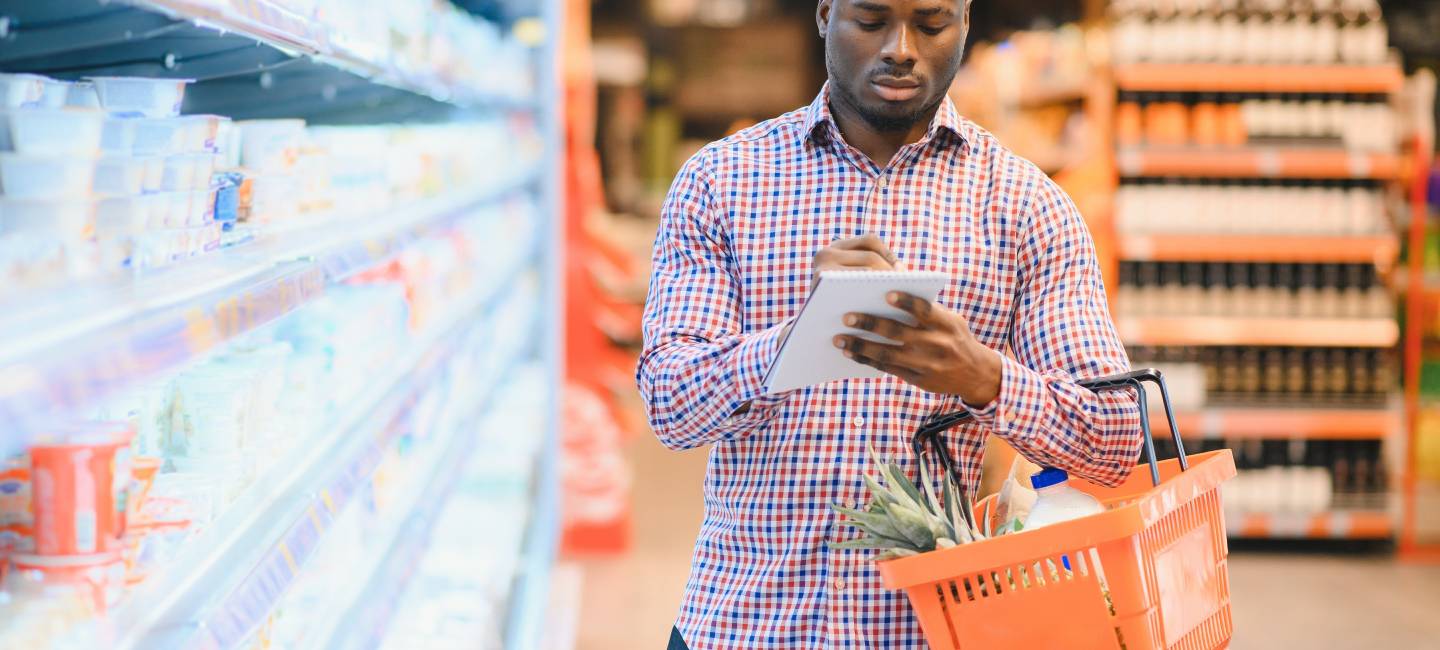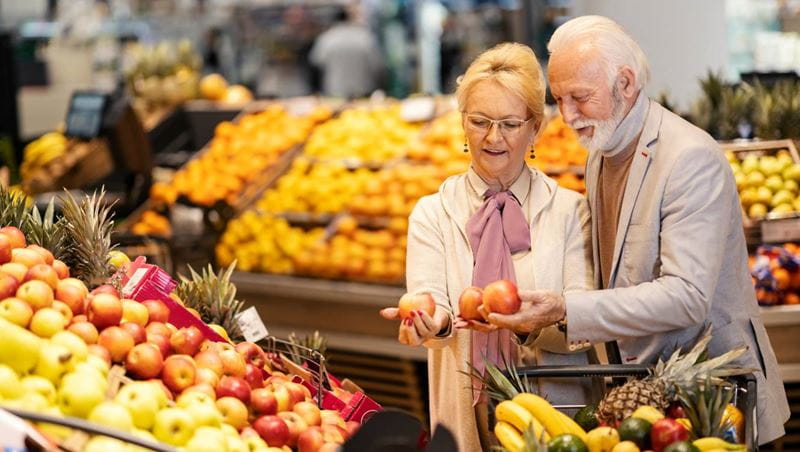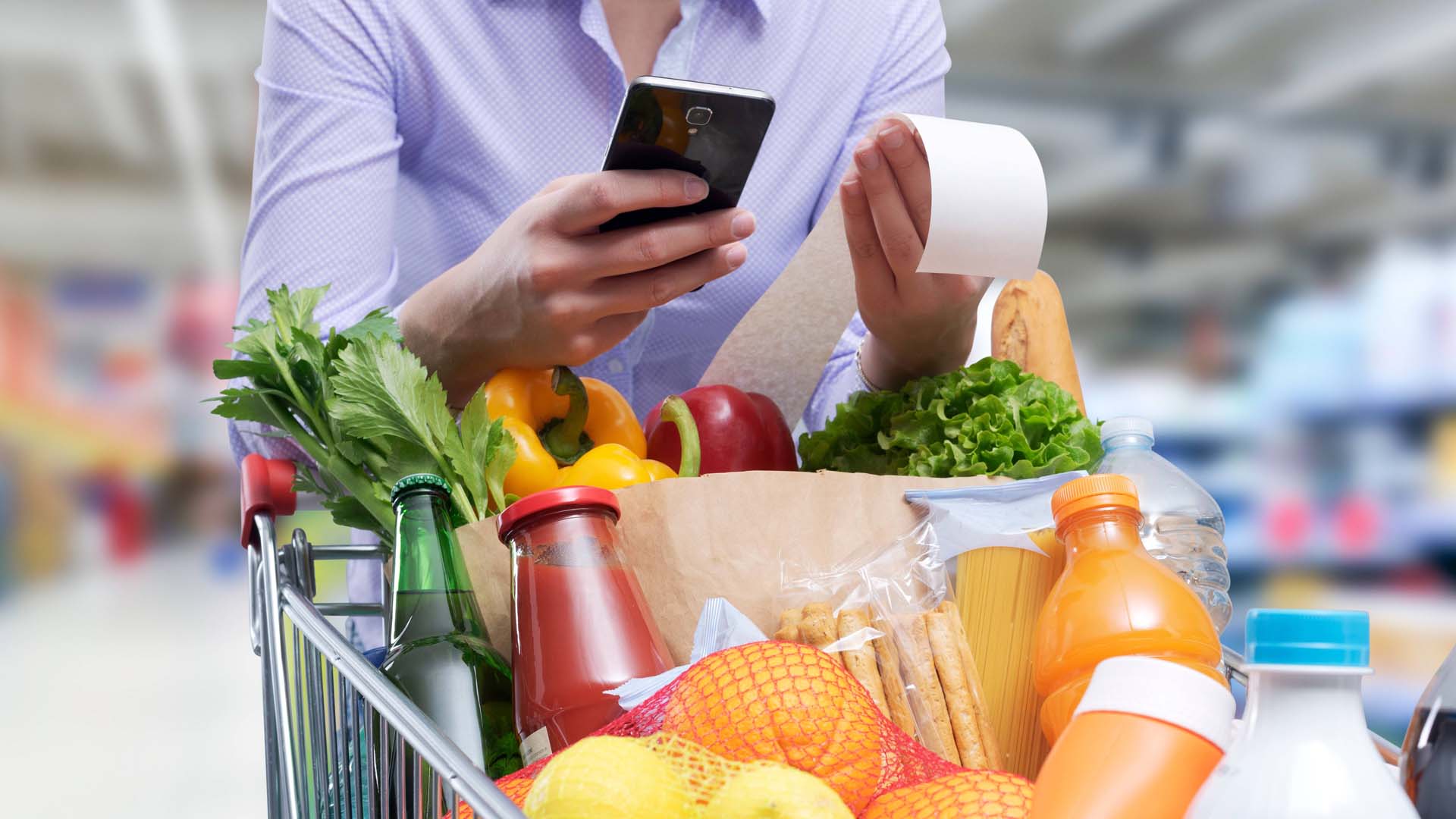
This article is for general guidance only and is not financial or professional advice. Any links are for your own information, and do not constitute any form of recommendation by Saga. You should not solely rely on this information to make any decisions, and consider seeking independent professional advice. All figures and information in this article are correct at the time of publishing, but laws, entitlements, tax treatments and allowances may change in the future.
A combination of global and domestic factors has created a perfect storm for rising food costs over the past year, turning once-affordable staples into budget-busting items.
If you’re on a fixed or low income, even small price hikes can mean tough choices at the checkout. But with a bit of planning, and an understanding of supermarket psychology, it’s possible to keep costs under control.
What’s on this page?
Food price inflation hit its highest level in more than a year in June 2025, with market researcher Kantar reporting that supermarket prices rose by 4.7% over the four weeks to 15 June, up from 4.1% the previous month.
Rising food prices were the biggest reason why overall inflation for May was still well above the government target, with the Consumer Price Index (CPI) at 3.4% year on year for May 2025.
That figure, which is based on an average ‘basket’ of goods and services, was down just slightly from April’s CPI figure of 3.5%. Chocolate, biscuits, and butters and spreads have been some of the fastest-rising food products in recent months.
Vix Leyton, consumer expert and host of the Spendology podcast, says: “Inflation, coupled with ongoing issues with Brexit and global political turbulence, alongside the increased cost of energy, means your shopping basket has never been more expensive.”
Waitrose-devotees may wince at downshifting to Aldi or Lidl, but budget supermarkets will save you a packet, even if you just buy some items there instead.
Consumer group Which? tracks supermarket prices each month and Aldi almost always works out to be the cheapest (closely followed by Lidl). In May 2025 the 82-product basket used for the research cost £135 at Aldi compared to £184 at Waitrose, a 36% difference.
Don't limit yourself to the main aisles when shopping at the supermarket. Less obvious sections often have surprisingly affordable products.
“For cooking staples like herbs and spices, check out the world food section – they’re often cheaper and allow you to buy in a bigger bulk. You’ll also find great value options on essentials such as tinned tomatoes, kidney beans, rice, chickpeas, herbs and spices,” says Leyton.
“Frozen fruit and veg can also be cheaper and last longer. The baby aisle offers low-priced beauty buys, such as body creams and cotton wool.”
For items with a long shelf life, buying online from places like Approved Food (a website that sells surplus foods online) or in warehouse-style stores like Costco (if you have a membership) can be significantly cheaper.
If you have a local market or greengrocer, check it out. It depends where you live, but prices for things like fruit and vegetables, especially in season, can be significantly lower.
Kevin Mountford, personal finance expert at Raisin UK, says: “Pre-grated cheese and pre-cut veg come at a cost for convenience.
“To see the difference clearly, look at the cost per kilo. For example, a kilo of Tesco mature grated Cheddar is £11, while a block of the same cheese costs £8 per kilo. That means simply swapping to a block and grating this can save you generously.
“Similarly, Tesco carrot batons are priced at £3.12 per kilo, whereas loose carrots are just 69p. It’s a significant mark-up for minimal effort.”
Choosing loose fruit and vegetables also means less packaging – so you’ll be helping the environment too.

Don’t be seduced by ‘three for two’ or ‘BOGOF’ (buy one get one free) deals, unless you genuinely need the extra items, as a few of these ‘bargains’ can significantly increase the total price of your shop.
Whilst it makes sense to buy at the cheapest price if it’s something you use regularly, don’t let offers persuade you to buy something you don’t need, especially if it ends up being thrown away.
Take a similar approach to ‘yellow sticker’ items that are reduced because the supermarket won’t be able to sell them the following day. They’re only a bargain if you have a plan for them or sufficient freezer space.
Sarah Coles, personal finance expert at Hargreaves Lansdown, says we’re more likely to buy things at eye-level. “Suppliers give supermarkets special deals in return for being placed there, and it’s the premium brands that can afford this. It means we’re more likely to buy the expensive version of the item rather than the own brand.” For the cheapest versions, look at what’s on the bottom shelf.
Supermarkets frequently change their store layouts as a strategic move to disrupt shopping routines, says Coles.
“Moving items regularly means we can’t pick up the usual things on autopilot, and will check out more items,” she explains. “Supermarkets put bulky or heavy items on special offer by the door, so you give up your basket in favour of a trolley and are no longer limited to buying what you can carry.”
Writing a shopping list before heading to the supermarket helps you stay focused and avoid impulse buys. Bear in mind that the supermarket is trying to get you to spend more, so that you can guard against it. As Vix Leyton says: “Every corner of the supermarket has been cleverly designed to increase your will to spend; from the piped-in smell of bread to the tempo of the music.”
A shopping list reduces the chances of forgetting essentials – saving extra trips (and extra spending). It also goes hand in hand with meal planning and batch cooking. Preparing larger quantities of stews, soups and curries means fewer cooking sessions, less energy used, and meals ready to reheat when you’re busy.
Bulk buying is worth it if the food lasts. Dry staples such as rice, pasta, dried beans, and oats keep for months, and the cost per serving can drop sharply when you buy big bags.
If you have freezer space, family-sized packs of chicken or minced beef cost less per kilogram than smaller portions. Split them into meal-sized bags when you get home so nothing is wasted.
Some people love supermarket shopping – you never know who you might bump into. However, if you want to save money, it might be worth switching to online grocery shopping. Lots of online shopping fans claim they spend much less this way.
Although you’ll still be presented with lots of deals and offers, it’s much easier to stick to your list when you’re shopping online. You won’t, for example, be forced to walk past the snack and biscuits aisle to get to your frozen blueberries.
Seeing the total value of your online basket, before you check out, also gives you the opportunity to prune or edit your choices before you check out.
If you’re spending more than you planned you can just delete a few items, without the shock of a big bill when you’re shopping in store.
If you can’t face online shopping, another option is to use a self-service scan gun, if your supermarket offers them. These let you to scan your shopping as you go, so it’s easy to keep track of how much you are spending, before paying at the designated check-out.
To use self-scan services, you’ll normally need to download an app to your phone and be a member of the supermarket’s loyalty scheme.
Too Good To Go is an app that connects shoppers with local shops, supermarkets, bakeries, and restaurants selling surplus food at discounted prices. ‘Surprise’ bags typically cost £3 or £4, which often equates to a discount of about 70% on the value of the food.
By rescuing this food, you not only save money but also help to reduce food waste in your community. The downside is that you generally don’t know what you’re going to get, and the food will often be on its “use by” date so will need to be eaten quickly, or frozen if it’s suitable for freezing.
Olio is a food waste app which offers free food that’s on its use-by or best-before date. It partners with supermarkets including Tesco and Sainsbury’s, as well as local stores and individuals who find themselves with food they won't use.
It also allows you to buy cut-price surprise bags at your local Iceland. For free food, you have to use the app to request food from a local volunteer. Most food tends to be available late in the evening as that’s when the supermarkets give it away.
If you’re struggling with the cost of your weekly shop, help may be available. There are low-cost community food shops in many areas, often open to anyone.
Food banks are community organisations that can help if you can’t afford the food you need. You might need a referral – from your GP, Citizens Advice, your local authority or social worker – to use one, although many independent food banks offer food without a referral.
Search online or ask your local Citizens Advice about community food shops or food banks.


Teachers can now get a Blue Light Card. Is the fee worth it? Discover the savings and top alternatives.

From sales to cashback, here’s how to get more for your money online.


From money back on your shopping to cut-price food, these are the best apps to save you money.